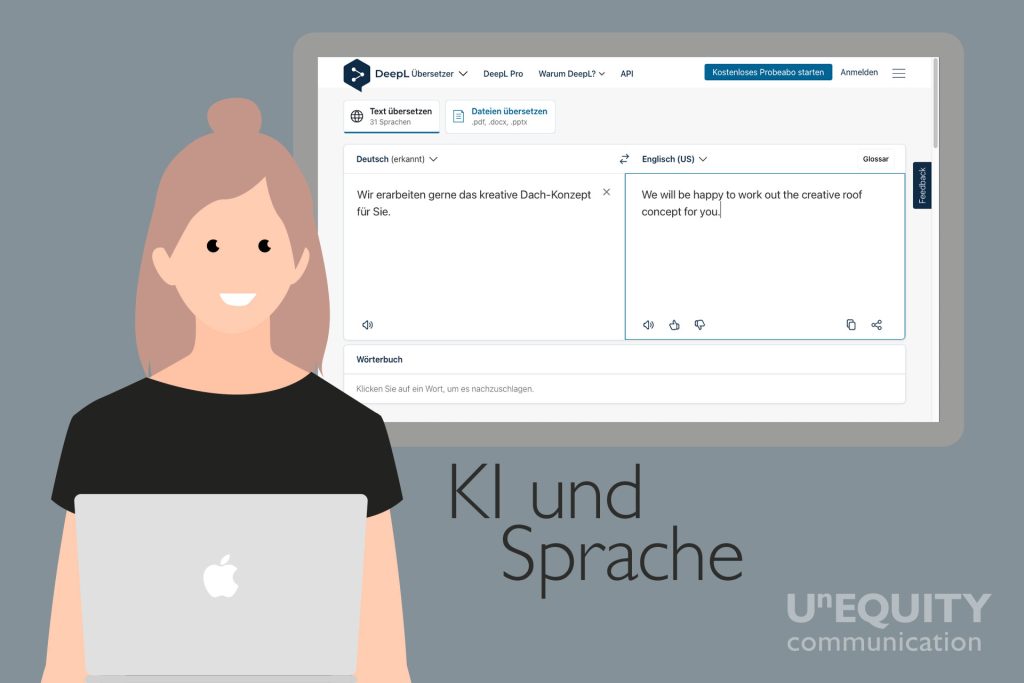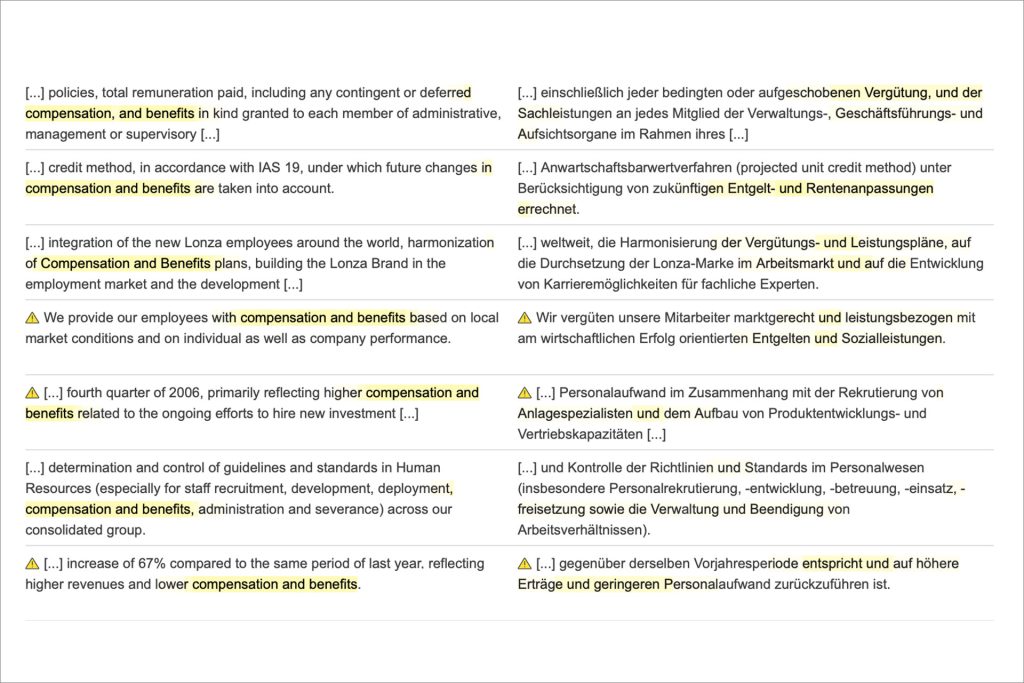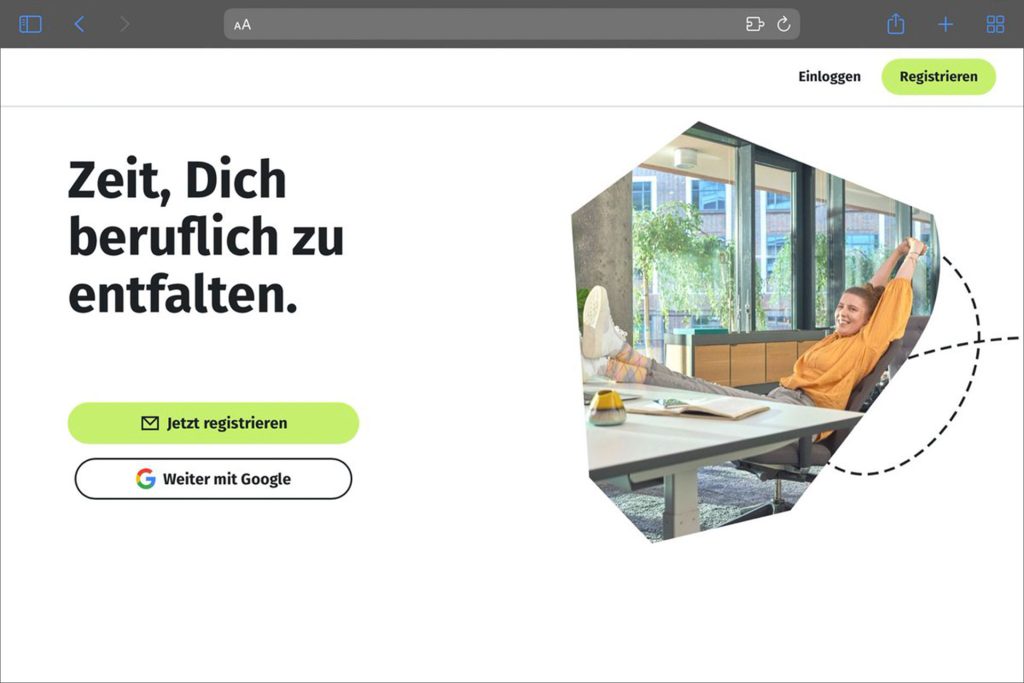
KI-Übersetzungstools im Check
Sprache ist „das Tool“ für verständliche Kommunikation. Sprache ist viel mehr als die Aneinanderreihung von Wörtern, Sätzen und ganzen Textbausteinen. Als Kommunikationsexpertinnen befassen wir uns täglich damit, Inhalte zu formulieren – sie leicht verständlich, überzeugend und im Ton unserer Kunden authentisch zum Ausdruck zu bringen. Unser Erfolg beruht dabei auf der Mischung von menschlicher Kompetenz und KI-basierter Software. Worauf man beim Einsatz von Übersetzungstools wie DeepL und Co. aber unbedingt achten sollte, berichtet unsere Kollegin Lynn Nothegger in diesem Beitrag.
Unequity ist auf die Mitarbeiterkommunikation spezialisiert. Unsere Aufgabe ist es, Programme und Angebote aus dem Personalbereich an alle Mitarbeitenden des Unternehmens weltweit oder an einzelne Gruppen der Belegschaft zu vermitteln. Welche Sprachen wir benötigen, entscheidet sich daher oft bereits während der Zielgruppendefinition. Und genau da werden wir immer häufiger gefragt, wie wir denn mit Übersetzungen umgehen.
Manche Kunden fragen uns, ob wir statt professioneller Übersetzer auch kostenfreie KI-basierte Übersetzungstools wie DeepL oder Google Translate nutzen können. Das ist zunächst eine sehr berechtigte Frage und die Antwort lautet: „Ja, klar!“. Wir alle haben diese Dienste schon benutzt, beruflich oder auch privat. Sie sind mittlerweile sehr gut und da es sich um künstliche Intelligenz handelt, lernen sie auch sehr schnell hinzu. Aber reicht die Qualität für professionelle Kommunikation im Geschäftsleben aus?
Dazu haben wir unsere Expertin befragt: Lynn ist Schottin und bei uns für englische Texte und Übersetzungen zuständig.
DeepL und Linguee

I first heard of DeepL around 2012 when a colleague asked me if I’d ever used it. When I investigated it, I was quite impressed. It was better than the other tools on the market at the time. Over time, I became more aware of the issues with DeepL and other AI tools.
As a German company, DeepL is probably the most popular translation tool in this country. The company’s initial product was Linguee, an online dictionary for language pairs. The Linguee software basically scrapes translations from multilingual websites and offers these examples of how others have translated words or phrases. Clever, I thought at first when I first discovered it. But we must remember that it’s artificial intelligence. As the screenshot above shows, it struggles with words that don’t have a clear translation.
“Compensation and Benefits” has a specific meaning in the HR field. “Compensation” includes wages and salaries, while “benefits” include things like pension plans, vacation time, and health insurance. In the image above, we can see that Linguee presents various translation options, some of them incorrect. When it comes to employee communications, it’s vital to be sure that we are using accurate language.
DeepL, Denglish, and false translations
The translation tool DeepL is based on the Linguee database. It is ‚learning‘ from German websites, so it picks up some incorrect translations. These are then being used by other German companies, which becomes a vicious circle of wrong translations. And I’ve noticed that there is a lot of Denglish on DeepL.
Denglish is a mix of Deutsch and English that is often used by German speakers. Some of these words are so common that you might not even realize that native English speakers don’t use them. Some have even been ‘eingedeutscht’ and are used in everyday language, even when speaking German. And sometimes English speakers like me, who live in Germany, use them too because they are so used to hearing them. You may have heard of the more common examples, like home office, handy, beamer, and public viewing, but there are a lot of less well-known examples, such as “offering” to mean “Angebot”, which I’ve written about in my LinkedIn newsletter.
If you use DeepL to translate text from German into English, you might not notice that the translation sounds odd to British or American readers. Or that the literal translation of an idiom from German to English makes it particularly difficult for non-native English speakers to understand. And that’s before we get to translations that aren’t just weird, they are incorrect. And sometimes weird and incorrect. I can’t prove that DeepL translated this one, but it was definitely not written by a native English speaker!


To unravel can mean “to unwind” or “to untangle”, like untangling your headphone cables, but it doesn’t mean “to develop your professional skills”, as the original German suggested. And since “unravel” can also mean a person falling apart and losing control, it’s not just wrong, it’s extremely negative.
Sometimes the translation tool will throw up a few different options. This is completely normal – if you ask ten translators to work on a text, they will word the translation slightly differently. It doesn’t mean one of them is correct and the other nine are wrong. Just that they chose slightly different words. With these translation tools, it can be challenging to know which is the right option. And some options will subtly change the meaning of the sentence, which can be difficult to detect if you aren’t a native speaker.
Data Protection and liability
Another thing to consider when using DeepL is liability and data protection. They explicitly state on their website that they accept no liability for the accuracy of translations. Not ideal when you are communicating highly complex information about, for example, an employee share purchase plan.
Only the Pro version of the site provides end-to-end data encryption, and the translation of personal data is restricted.
Professionelle Mitarbeiterkommunikation beinhaltet auch professionellen Sprachentransfer
Bei unseren Projekten setzen wir standardmäßig Software ein. Neben Projektmanagement- Software unter anderem auch DeepL und andere Übersetzungstools. Wie aber die Beispiele unserer Kollegin Lynn zeigen, verlassen wir uns nicht zu 100% auf die künstlichen Übersetzungen. Für uns bedeutet professionelle Kommunikation neben der Richtigkeit der Inhalte auch, dass ein für den Kunden passender Ton gewählt wird, dass wir gelernte Begriffe nutzen und nicht willkürliche (wenn auch vorerst richtige) Übersetzungen einfach weitergeben. Wir arbeiten mit verschiedenen Übersetzungspartnern zusammen, bei denen wir selbst bei komplizierten Fremdsprachen davon ausgehen können, dass menschliche Kompetenz und moderne Hilfsmittel, wie KI-basierte Übersetzungssoftware, zum Einsatz kommen. Der menschliche Qualitätscheck ist für uns keine Kür, sondern Standard – genauso wie ein guter Basistext auf Deutsch oder Englisch.
Externe Verlinkungen:
In ihrem LinkedIn-Newsletter stellt Lynn weniger bekannte Denglisch-Fehler vor. Abonniert den Newsletter, um Tipps zur Verbesserung eurer Englischkenntnisse zu erhalten:
https://www.linkedin.com/newsletters/6935228618771988480
DeepL – Hier findet ihr das kostenfreie Tool:
https://www.deepl.com/de/translator
- Dieser Beitrag wurde veröffentlicht am